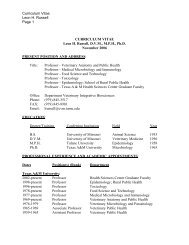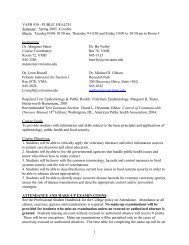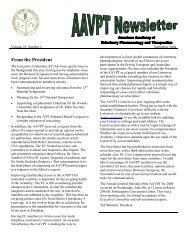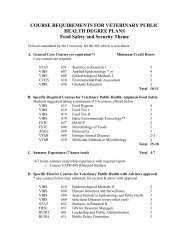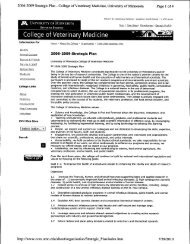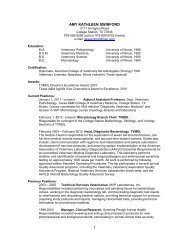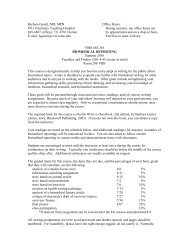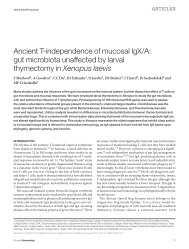BreakOut Session Addendum to the October 2008 Antimicrobial ...
BreakOut Session Addendum to the October 2008 Antimicrobial ...
BreakOut Session Addendum to the October 2008 Antimicrobial ...
Create successful ePaper yourself
Turn your PDF publications into a flip-book with our unique Google optimized e-Paper software.
<strong>Antimicrobial</strong> workshop Breakout session discussion<br />
Page 3<br />
<strong>the</strong> ELF in a labora<strong>to</strong>ry study. For upper respira<strong>to</strong>ry infections, evaluation of clinical<br />
parameters during treatment and relapse period, as well as methods for assessing<br />
reduction in pathogen counts pre and posttreatment, were proposed. Pathogen reduction<br />
could be assessed in a labora<strong>to</strong>ry study or in a subgroup of <strong>the</strong> patient population in <strong>the</strong><br />
clinical study. Recommendations were made for inclusion of an active control, his<strong>to</strong>rical<br />
control, or negative control group with rescue. Participants expressed concern about<br />
using a negative control for LRTI (pneumonia) in a field study or requiring cultures as<br />
part of <strong>the</strong> entrance criteria for LRTI. One proposal was <strong>to</strong> do a labora<strong>to</strong>ry study with a<br />
negative control, <strong>to</strong> show a clear difference in <strong>the</strong> disease outcome with <strong>the</strong> treatment and<br />
control group, followed by a smaller clinical study using an active control.<br />
For example:<br />
Both lower and upper respira<strong>to</strong>ry disease could be incorporated in<strong>to</strong> one study. Half <strong>the</strong><br />
cases would be URTI and half would have LRTI. In this scenario, cases having both<br />
URTI and LRTI would be excluded. All cases would need <strong>to</strong> be evaluated at <strong>the</strong> end of<br />
<strong>the</strong> treatment period of <strong>the</strong> study and for a defined posttreatment period <strong>to</strong> assess<br />
possible relapse. A “successful” case would be one that was considered a “success” at<br />
both time points. Suggestions for evaluating effectiveness of an URTI included <strong>the</strong> use of<br />
CT or MRI of sinuses in a small labora<strong>to</strong>ry study as a means <strong>to</strong> objectively assess drug<br />
effectiveness prior <strong>to</strong> <strong>the</strong> clinical field study.<br />
For hemoparasites, <strong>the</strong> development of reliable disease models or <strong>the</strong> use of his<strong>to</strong>rical<br />
controls were discussed. The indication would likely be control, ra<strong>the</strong>r than treatment,<br />
and <strong>the</strong> majority believed that experts should be consulted regarding <strong>the</strong> appropriate<br />
endpoints <strong>to</strong> measure in a hemoparasite effectiveness study.<br />
II. When defining an indication, what infections can be lumped <strong>to</strong>ge<strong>the</strong>r?<br />
Considering <strong>the</strong> drug, microbe, PK information, pharmacodynamic information<br />
for <strong>the</strong> specific drug/pathogen combination, and target site, for what o<strong>the</strong>r<br />
indications could we use <strong>the</strong> drug?<br />
Considering <strong>the</strong> drug, ‘bug’, PK information and target site – for what o<strong>the</strong>r<br />
indications could we use <strong>the</strong> drug?<br />
The specific case example described a fluoroquinolone already approved <strong>to</strong> treat<br />
wounds and abscesses in dogs. The sponsor would now like <strong>to</strong> obtain an<br />
indication for <strong>the</strong> treatment of UTI in dogs, perhaps including both upper and<br />
lower UTI.<br />
Again, <strong>the</strong> question was addressed from two different perspectives: first, as described in<br />
<strong>the</strong> case example, <strong>the</strong> sponsor is seeking approval for an additional indication for a drug<br />
already approved in a species for a different indication; second, a sponsor would like <strong>to</strong><br />
have a concurrent approval of an original NADA for two different indications.




